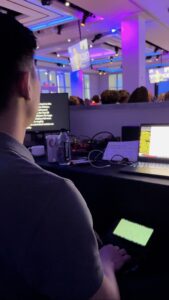 By Anissa R. Nierenberger
By Anissa R. Nierenberger
Broadcast and CART captioners comprise only 4.3 percent of NCRA’s membership. That’s a pretty tiny sliver! So why should you consider crossing over into these realtime career options? Because the growth rate for these careers will outpace the growth for court reporters past 2018. Benefits of these jobs include getting to live wherever you’d like because these jobs can be done remotely as long as you have access to reliable Internet. Transcript pages will no longer hang over your head like a dreadful gray cloud. A consistent work schedule that you’ll know up to a month ahead of time will reduce the stress of last-minute changes. And commute time?
Let’s see, how long does it take you to walk into your home office? Most important of all, many court reporters who have walked away from the courtroom or a deposition find that the change to captioning makes them feel that they have contributed to the deaf and hard-of-hearing community. The rewards of opening doors to a world that wouldn’t exist without translation is incomprehensible until you get to experience it yourself.
The question is: How does one get from point A to point B? It’s like following a recipe — we follow the steps in the proper order. We use the right ingredients. Let’s get cookin’!
1. Edit for your dictionary
2. Create a solid realtime foundation
3. Enter prefixes, suffixes, word pieces
4. Build up the dictionary
5. Learn broadcast and CART captioning styles
Editing for your dictionary is a trick I was taught almost 25 years ago by captioner Janet Cassidy Burr, RDR, CRR, CRC, CPE. She would look over my shoulder as I edited my television practice files. When I would select a three-syllable word to define, she’d say, “Ah, ah, ah, no! Define every stroke first by itself.” I will admit that it took me weeks to catch on to this, but I’m forever thankful for her strictness. As an example, if I wrote <PHABG>/<TKAEUPL>/<KWRA>, instead of defining this as macadamia, I would define mac, then dame, then ya, just as words. Then I can define it all together as macadamia. Just editing in this way will improve your realtime. Try defining every single untranslate all by itself. In as little as two weeks, you’ll see what I mean.
A strong realtime theory is the foundation of a successful CART or broadcast captioner. If you’ve been struggling on your own to clean up realtime, you are not alone. How can you teach yourself something that you do not know? How does a figure skater become an Olympian? Certainly not on his or her own; very often, that person has a coach. Creating a strong foundation involves resolving word boundary issues and updating dictionary entries to reflect these changes. Do we have conflicts? Let’s create consistency, tackle them, and resolve them.
How are we going to commit these changes to memory? We’ll use FPP55 — focused phone practice, five things for five minutes. On Monday, choose five briefs you want to learn or five words that require a theory change, and dictate them into your phone. Create silly sentences using your five words. No one will hear them but you. Practice for five minutes one to three times per day and voilà; by Friday, they’ll be resolved. I was given six months to completely transform my theory into realtime. Focused practice is how I did it. It works. Once we’ve strengthened our realtime skills, we move on to the next layer in our captioning cake.
Entering prefixes, suffixes, and word pieces will help you to write the entire cake. Court reporters write part of the cake, but realtime captioners write the entire cake — every delicious piece. We need the ability to create words on the fly, and these three elements allow us to accomplish this task. There are approximately 450 prefixes and su ffixes that you can enter into your dictionary. If a word piece is not a prefix or a suffix, we simply define it as a word. Yes, it is okay to do this. Examples of word pieces are pire, nom, journ, gam, drome, and dem.
Dictionary building is getting us closer to the top of our captioner cake. Every word you have ever learned in your entire life should be able to translate in your CAT software — and then some. We know the words baklava, ambrosia, gingerbread, true, brittle, and grasshopper, but are they in our stenographic dictionaries? Not only do we need to enter these words into our dictionaries, but it’s a good idea to enter words to prepare for every possibility of how we may write them. Enter slop shots, brief forms, splitting syllables differently, etc. Cover your bases.
In the January 1998 issue of the Journal of Court Reporting, Patty White and Kevin Daniel, RDR, CRR, CRC, supplied a list of vocabulary needed for “Developing your stenocaptioning skills.” This article is what helped inspire me to truly round out my dictionary. I took this very seriously and started copious amounts of research so that my dictionary and I could do the best job we could. A captioner with a well-developed dictionary is a confi dent captioner. Notice I did not say “cocky” captioner. There’s always room for improvement, and prep is never history for anyone until we put the writer away once and for all.
CART and captioning style is very different from court reporting. First, while we are not required to write verbatim, we try our best. We have a license to edit when and where necessary for speed and content. Second, captioning is most always displayed in all capitals, and ending punctuation starts a new line. Broadcast captioning descriptors use brackets, and CART descriptors use parentheses. We learn the style and we practice — a lot. We’re writing very different vocabulary than we’re used to, so repetition is key. To start introducing new vocabulary into your writing, log on to ted.com and choose a TED Talk. Hint: Write from the verbatim transcript first to enter the vocabulary into your dictionary, then write the live talk. Speed comes first, then accuracy, then we’ll get down to the nitty-gritty total accuracy ratio, which needs to be at least 98.5 percent to be broadcast ready. Captioning is needed for all sports, local and national newscasts, financial calls, legislature sessions, talk shows, religious programming, educational and business CART, to name a few. The list goes on and on.
If you follow the steps and are diligent in your efforts, the cake will be delicious. The icing on the top is you can live wherever you would like, ditch the transcripts, have a consistent schedule, and forego the work commute. Best of all, at the end of the day, you’ll have a warm, gooey feeling that you indeed helped someone. After all, you’re an A+ captioner. Oh, how sweet it is.
Anissa R. Nierenberger, RPR, CRR, CRC, CRI, is a 24-year captioner and is the creator of Dictionary Jumpstart, a realtime dictionary-building software. She has published Simple Syllables and A Jump Back in Time. Anissa is an instructor for EduCAPTION and provides online one-on-one realtime training, CART training, and Caption Masters broadcast captioning training. She can be reached at Anissa@LearnToCaption.com or through her website LearnToCaption.com.










